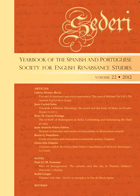
Sederi 22
Sederi 22 — 2012
EDITORS
Berta Cano Echevarría & Ana Sáez-Hidalgo
REVIEW EDITOR
Francisco J. Borge López
ISSN 1135-7789
Paul J.C.M. Franssen, “Sites of transgression: The suburbs and the city in Thomas Dekker’s Shoemaker’s Holiday.” SEDERI 22 (2012): 139-154.
DOI: https://doi.org/10.34136/sederi.2012.7 Download PDF
Abstract
The early modern binary of the virtuous City of London versus the sinful suburbs clashes with an older binary pitting the countryside against the city. At the same time, the forces of urbanization along with early capitalism were undermining both binaries. This article traces how this is reflected in Thomas Dekker’s The Shoemaker’s Holiday. The play not only represents the City of London under Simon Eyre’s rule as, potentially, possessing all the virtues of the pastoral, but also suggests that the surrounding countryside, in particular the village of Old Ford, was being corrupted by city values. Dekker’s play, therefore, deconstructs simple dichotomies between country and city, showing how the two inevitably influence each other.
Keywords: Thomas Dekker; The Shoemaker’s Holiday; City Comedy; Countryside.
References
Chaudhuri, Sukanta 1989. Renaissance Pastoral and its English Developments. Oxford: Clarendon Press.
Dekker, Thomas 1979 (1599). The Shoemaker’s Holiday. The Revels Plays. Ed. R. L. Smallwood and Stanley Wells. Manchester: Manchester University Press.
Dekker, Thomas 1990 (1599; 1975). The Shoemaker’s Holiday. New Mermaids. Ed. Anthony Parr. London: A & C Black.
Greenblatt, Stephen 1980. Renaissance Self-Fashioning from More to Shakespeare. Chicago and London: The University of Chicago Press.
Hayes, Carol 2000. “Mapping City Comedy Topographies of London and the Anomalous Woman, 1599-1625.” Diss. University of California, Irvine.
Howard, Jean E. 2007. Theater of a City: The Places of London Comedy, 1598-1642. Philadelphia: University of Pennsylvania Press.
Li, Chi-Fang Sophia 2009. Review of The Shoemaker’s Holiday at the Rose Theatre London, November 2008. Shakespeare Bulletin 27/3: 146-150.
Maddocks, Sydney 1933. “Old Ford.” The Copartnership Herald 3/31. <url: www.mernick.org.uk/thhol/oldford.html>. Last accessed 22/08/2011.
Manheim, Michael 1970. “The Construction of The Shoemaker’s Holiday.” Studies in English Literature, 1500-1900 10/2: 315-323.
McRae, Andrew 1996. God Speed the Plough: The Representation of Agrarian England, 1500-1660. Cambridge: Cambridge University Press.
Mullaney, Steven 1982. The Place of the Stage: License, Play, and Power in Renaissance England. PhD Thesis. Stanford University. Ann Arbor: University Microfilms International. (Later published as a book: Chicago-London: University of Chicago Press, 1988).
Mortenson, Peter 1976. “The Economics of Joy in The Shoemakers’ Holiday.” Studies in English Literature, 1500-1900 16/2: 241-252.
Nicholl, Charles 2007. The Lodger: Shakespeare on Silver Street. London: Penguin.
Scott Kastan, David 1987. “Workshop and/as Playhouse: Comedy and Commerce in The Shoemaker’s Holiday.” Studies in Philology 84/3: 324-337.
Seaver, Paul S. 1995. “Thomas Dekker’s The Shoemaker’s Holiday: The Artisanal World.” Eds. David L. Smith, Richard Strier and David Bevington. The Theatrical City: Culture, Theatre and Politics in London, 1576-1649. Cambridge: Cambridge University Press: 87-100.
Smith, Amy L. 2005. “Performing Cross-Class Clandestine Marriage in The Shoemaker’s Holiday.” Studies in English Literature, 1500-1900 45/2: 333-355.
Straznicky, Marta 1996. “The End(s) of Discord in The Shoemaker’s Holiday.” Studies in English Literature, 1500-1900 36/2: 357-372.
Twyning, John 1998. London Dispossessed: Literature and Social Space in the Early Modern City. Houndmills, Basingstoke: Macmillan Press.
Williams, Raymond 1973. The Country and the City. London: Chatto and Windus.
Wilson, Richard 1992. “‘Like the Old Robin Hood’: As You Like It and the Enclosure Riots.” Shakespeare Quarterly 43/1: 1-19.
